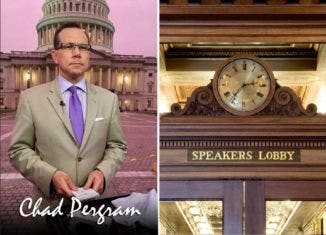Seeing Is Believing
The Speaker’s Lobby: Seeing Is Believing
By: Chad Pergram, FOX News
28 January 2010
Eighty-six-year-old Gertrude Bridgeforth of Southaven, MS, marched with Martin Luther King Jr. during the civil rights movement. And she volunteered for 15 years at the National Civil Rights Museum in Memphis. But as someone who lived through the civil rights struggle, Bridgeforth knows you can achieve a lot. And still not attain your goal.
“We’ve come a long way. We have come so far,” Bridgeforth said of the barriers hurdled by African Americans over the past 50 years.
Such was the case last January when Bridgeforth traveled from Mississippi to Washington to witness the inauguration of the first African American president in U.S. history. And as she says, you can come a long way. You can come so far. But still fall short.
Which is precisely what happened to Bridgeforth.
Living in the south, Bridgeforth witnessed the Jim Crow policies that made it hard for blacks to vote or attend school. But the obstacle that prevented Bridgeforth from watching President Obama’s inauguration from the National Mall wasn’t a poll tax or a governor standing in the schoolhouse door.
Bridgeforth’s barrier was the Purple Tunnel of Doom.
Thousands of people holding tickets admitting them to the “purple” seating section in front of the Capitol for Mr. Obama’s inauguration nicknamed Washington’s Third Street Tunnel the “Purple Tunnel of Doom.” The massive interstate highway tunnel that traverses Mall near the Capitol was closed to vehicular traffic and converted into a walkway for those attending the ceremony. But the crush of people who descended on the city was so great that they clogged the tunnel exits. And thousands of people, mostly bearing purple tickets, were snarled in the tunnel and missed the inauguration.
Gertrude Bridgeforth held a “gold” ticket for the inauguration. But Bridgeforth, who uses a walker, realized around 9:45 am that the tunnel had her beat. She was going to miss the inauguration of the 44th president of the United States. So she turned around and watched the speech instead on a gigantic television at nearby Union Station, located just blocks from the Capitol.
Bridgeforth traveled 1,000 miles. And still came up short of her goal.
“I was so glad to see the first African American inaugurated. It didn’t much matter,” Bridgeforth said. “But I was disappointed.”
She wanted to see the first African American president in person.
And Bridgeforth’s dream came true at President Obama’s first State of the Union speech. Albeit a year late.
Like many who attended the inauguration, Bridgeforth secured a ticket from her Congressman, Rep. Travis Childers (D-MS). So after the inauguration snafu, she complained to Childers. And the Mississippi Democrat promised he’d find a way to make it up to Bridgeforth.
“It hurt me,” said Childers. “She made a great effort. I was bothered even though she was such a great sport about it.”
Childers worked with House Majority Leader Steny Hoyer (D-MD) and Majority Whip Jim Clyburn (D-SC) on the possibility of Bridgeforth attending the president’s State of the Union address this year. The House allots each lawmaker one seat in the viewing gallery, usually reserved for a spouse. Childers’ wife Tami already attended a Joint Session last year. And Tami graciously gave up her seat next to the First Lady’s box so Gertrude Bridgeforth could attend.
Bridgeforth has seen a sitting president in person before. She saw LBJ “up pretty close” during a campaign stop in Memphis in 1964. But she wanted to see Barack Obama in person.
Bridgeforth recalled what she observed on January 20, 2009 from the TV screen at Union Station.
“I saw a young, intelligent African American man,” she said. “I would say he is one who came up through great tribulation. We’re on our way.”
And Wednesday night, Gertrude Bridgeforth was on her way to see President Obama.
Bridgeforth donned a light green pantsuit accompanied by a yellow and pink scarf. And she gazed forth from viewing gallery as President Obama took the lectern before a packed House chamber. This time, Mr. Obama was in the flesh. Not digitized into pixels on a monitor across town.
During his address, the president spoke of how “civil rights marchers were beaten on Bloody Sunday.” And he underscored efforts by the Justice Department to protect everyone “no matter who you are or what you look like.”
Long before President Obama was born, Bridgeforth helped register African Americans to vote in the 1950s and ‘60s.
“I did that when it wasn’t popular,” she said. “I have tried to tell the story of how we have overcome.”
Her husband of 63-years, Eddie, served in the segregated Army during World War II. She spoke of how the residents of Durham, NC, were asked to pull their shades so they didn’t have to see African American troops as they rolled through town.
As a mother in the late 1950s, her newborn baby fell ill and none of the doctors could figure out what was wrong. Finally, one specialist agreed to see them. But only after he finished with the white patients first. Bridgeforth says the doctor asked her to enter his office through a separate door and take a seat on the floor in the hall until he was ready to see her child.
Just a few hours before the speech, Travis Childers reminded Bridgeforth that she no longer had to suffer those indignities.
“Tonight you’re not going to sit in the hall. You’re going to sit there with the First Lady of the United States,” Childers said of her of her special ticket, just feet away from Mrs. Obama.
“And now I can go in any door I want to,” Bridgeforth said.
Bridgeforth did more than just sit near the First Lady during the speech. Afterwards, she met the first couple and got her picture taken with them. She also invited Mrs. Obama to visit Mississippi. And she said it was a thrill to meet the president.
“I hugged him and I told him I loved him,” Bridgeforth said. “It was the dream of a lifetime.”
Not just a dream. In this case, seeing is believing.
- Chad Pergram covers Congress for FOX News. He’s won an Edward R. Murrow Award and the Joan Barone Award for his reporting on Capitol Hill.
- The Speaker’s Lobby refers to a long, ornate hallway that runs behind the dais in the House chamber. Lawmakers, journalists and aides often confer there during votes.

